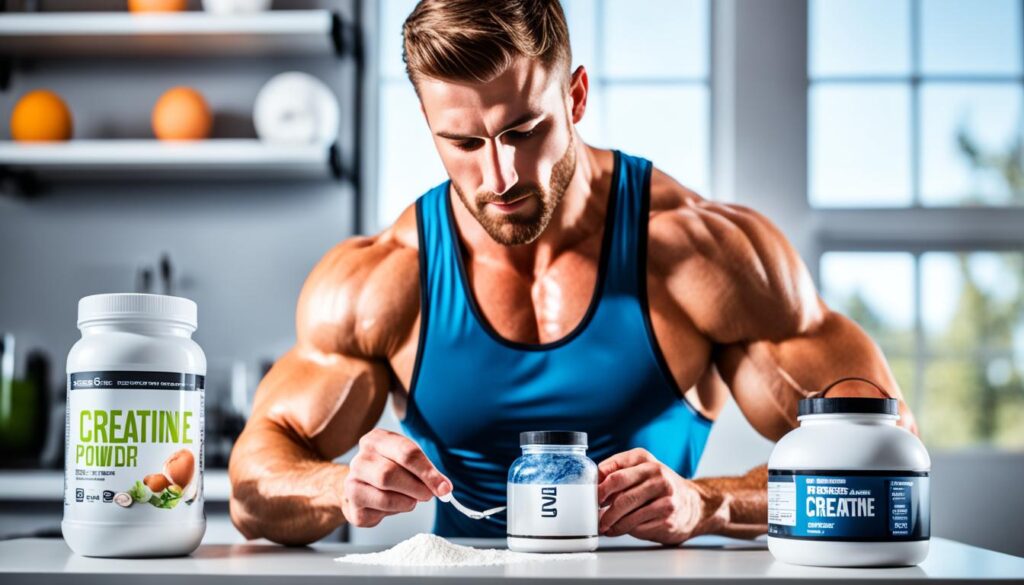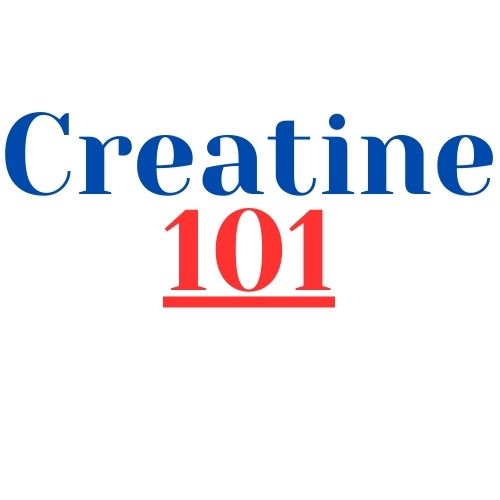Did you know that a simple creatine loading phase for athletes can augment muscle strength by 10-40% almost instantly? As I continue to explore the vast landscapes of performance enhancement, I’ve encountered compelling evidence that indicates a proper creatine loading phase can boost performance significantly. This strategy, often adopted by elite competitors, involves high dosages of creatine consumption over a short period to saturate muscle stores effectively, thereby securing a competitive edge.
Grounded in science and applied with optimal strategies, the dosages during this critical phase are meticulously calculated, introducing a rapid and potent boost to my training regimen. Creatine, a naturally occurring substance with a proven track record for safety and efficacy, isn’t just a supplement; it’s a game-changer for athletes like me looking to elevate our game. By adopting a structured creatine loading phase, we set the stage for enhanced athletic prowess that could be the deciding factor in our next competition.
Key Takeaways
- The creatine loading phase leads to a rapid increase in muscle creatine content, thereby enhancing muscle strength.
- Aloading phase is typically followed by a maintenance dose to sustain the increased creatine levels.
- Creatine supplementation is key for athletes seeking to boost performance quickly.
- Adopting optimal strategies and dosages is critical to maximizing the benefits of creatine loading.
- The safety and efficacy of creatine loading have been substantiated through rigorous scientific research.
The Science Behind Creatine Loading
Understanding how creatine works at the biological level provides insight into the benefits of creatine loading. The human body naturally produces this compound, and it’s also found in dietary sources, particularly meat and fish. However, these natural avenues often fall short of fully saturating muscle creatine stores. Here’s where creatine loading steps in, formulating a protocols designed to reach and maintain high levels of muscle creatine over a short period.
How Creatine Loading Quickly Increases Muscle Strength
By following the best creatine loading methods, athletes can experience significant muscle strength gains. This entails consuming a high dosage of creatine, typically 20–25 grams daily, divided into four or five servings to prevent saturation of the creatine transporter and minimize any potential side effects. The heightened levels of creatine in the muscles lead to improved energy production, especially during high-intensity activities, which is crucial for athletes who require bursts of speed and power.
Optimal Duration for Creatine Loading Phase
The creatine loading protocol operates on a short-term schedule. Saturation is generally achieved within a period of approximately five to seven days, after which the athlete transitions to a maintenance phase. This immediate loading strategy contrasts with the steady, slower accumulation from dietary sources, spotlighting the effectiveness of the supplemental approach for rapid performance benefits.
Natural Creatine Production vs. Supplementation
While our bodies produce creatine naturally at a rate of about 1–2 grams per day, this endogenous production coupled with a regular diet typically saturates only 60–80% of the muscle’s storage capacity. Creatine loading, therefore, fills the remaining gap, topping off the stores to enhance the overall benefits of creatine, which includes its role in increasing muscle mass, reducing fatigue, and improving recovery times.
Here’s a comparative look at the creatine loading phase versus natural creatine levels:
| Creatine Source | Daily Amount | Duration for Saturation | Performance Benefits |
|---|---|---|---|
| Natural Production & Diet | 1–2 grams | Indefinite (60–80% saturation) | Moderate |
| Creatine Loading | 20–25 grams | 5–7 days (Full saturation) | Significant |
| Maintenance Post-Loading | 3–5 grams | Ongoing | High |
By adhering to a scientifically-backed creatine loading protocol, athletes can maximize these benefits of creatine loading, making it a cornerstone in the pursuit of peak performance and endurance.
Creatine Loading Phase for Athletes: A Detailed Protocol

Embarking on how to properly do a creatine loading phase is a highly regarded strategy among athletes aiming to enhance their muscular endurance and strength. The process, concise yet impactful, involves a regimented intake of creatine over a specific timeframe to elevate muscle creatine stores rapidly. My focus today is on guiding athletes through this strategic phase, befitting both creatine loading for endurance athletes and those engaged in creatine loading for strength training.
Calculating Daily Creatine Dosage Based on Body Weight
To initiate the phased approach, I calculate my daily creatine intake specifically tailored to my body weight. The formula used is relatively simple: body weight in kilograms multiplied by 0.3. This personalized dosage ensures that I’m ingesting an optimal amount of creatine that will allow my muscles to reach full saturation effectively without overconsumption.
Maintaining Creatine Levels Post-Loading
Once the initial loading phase is completed, the subsequent crucial period is maintaining the elevated creatine levels. I continue with a daily intake of 3 to 5 grams to keep my muscles well-saturated. My goal is to prevent the natural decline of creatine concentrations, ensuring that the benefits of the loading phase are not lost but rather sustained to support my training regime and competitive performance.
Though the process may appear daunting, following a structured and well-planned creatine loading phase plays a pivotal role in advancing athletic capabilities. Whether my focus lies in endurance or strength, kudos to a concrete plan for nurturing peak muscle creatine stores.
Pros and Cons of Creatine Loading Versus Maintenance Dosing
When devising effective creatine loading strategies, a key concern is choosing between a high-dose creatine loading cycle and a more gradual maintenance dosing regimen. This decision significantly affects not only the timing and efficacy of muscle saturation but also factors in the individual’s unique response to creatine supplementation.
Comparing Timelines: Loading Phase vs. Gradual Supplementation
The creatine loading phase targets immediate muscle store saturation, typically unfolding over a 5-7 day period with significant daily doses of creatine. Conversely, gradual supplementation steers clear of the initial surge, opting for a long-term approach that slowly builds up muscle stores with lower daily doses, taking around a month to reach similar creatine levels.
With my approach, I consider an athlete’s immediate needs, weighing the quick benefits of a creatine loading cycle against the steady, extended uptake of a maintenance plan. For some, the urgency of forthcoming competitions may sway them towards loading, while others may prioritize consistent, measured intake to reduce potential side effects.
Maximizing Muscle Stores: Immediate vs. Long-Term Strategies
While a loading phase rapidly increases muscle stores, providing an expedited boost in performance remains a primary allure. The alternative, a maintenance dose, requires patience, taking up to four times longer to saturate the muscles fully, although it’s known to eventually align with the results achieved through loading.
It’s paramount for me to advise on the pros and cons of each method, ensuring that the athlete is informed about the creatine loading cycle’s time efficiency against a lower-risk, steady maintenance dose. This guarantees a bespoke supplementation protocol aligns with the sportsperson’s goals and personal health requirements.
Understanding the Benefits of Creatine Loading

As I delve into the advantages of creatine loading, it’s essential to understand the holistic effect this practice has on athletes. While it’s commonly associated with increasing muscle creatine stores, the benefits of creatine loading offer a broader spectrum of enhancements, influencing several aspects of fitness and wellbeing.
Enhanced Muscle Mass and Strength
One of the profound advantages of creatine loading is the visible increase in muscle mass and strength. This isn’t merely anecdotal; numerous studies back up these claims, indicating that when combined with rigorous resistance training, creatine loading can lead to considerable gains. The mechanism behind this involves the saturation of muscle phosphocreatine stores, which fuels the muscles during intense physical activities, allowing for more robust and prolonged training sessions.
Improved Athletic Performance and Injury Prevention
Focusing on the improved athletic performance, creatine loading contributes significantly to an athlete’s ability to perform high-intensity exercises. It enhances power output and sprint performance, which can be the difference between winning and losing in competitive sports. Moreover, by contributing to muscle hydration, creatine helps in minimizing muscle cramping, thereby reducing the risk of sports-related injuries. Hence, consistent creatine loading not only propels an athlete’s performance metrics but also serves as a preventive measure against muscle strains.
| Performance Metric | Effect of Creatine Loading |
|---|---|
| Muscle Strength | Significant Increase |
| Power Output | Enhanced during high-intensity workouts |
| Sprint Performance | Improved burst capabilities |
| Injury Prevention | Reduced muscle tightness and cramping |
Understanding these benefits reshapes how we view creatine loading, elevating it from a mere supplement to a comprehensive performance enhancer and protective agent. It stands as a testament to the multifaceted benefits of creatine loading for any athlete eyeing a competitive edge and longevity in their sporting career.
Potential Side Effects and Safety Concerns with Creatine Loading
While many athletes successfully use creatine supplementation to augment their performance, understanding the possible side effects and safety considerations is crucial. Following creatine loading dosage recommendations is essential to minimize potential risks. I want to highlight that consuming up to 30 grams per day is typically well-tolerated by healthy individuals. Still, side effects such as gastrointestinal discomfort and temporary weight gain can occur.
Increased water retention in the muscles is a known result of creatine loading, which could explain instances of weight gain. Furthermore, attention should be directed towards those with pre-existing kidney concerns due to the implications of creatine on renal functions. It’s imperative for anyone considering creatine supplements to consult with a healthcare provider beforehand, especially if there’s a history of health issues. Here, I’ll break down some commonly reported creatine side effects:
- Gastrointestinal discomfort
- Muscle cramping
- Nausea
- Dehydration
It should be noted that these side effects are not typically severe and often subside after the body acclimates to the supplement. However, let’s detail the specific concerns and guidelines in the table below to understand better how to approach creatine loading safely.
| Side Effect | Prevention Strategies | When to Consult a Doctor |
|---|---|---|
| Gastrointestinal Discomfort | Split dosages throughout the day, Stay hydrated | Persistent symptoms, severe pain |
| Weight Gain | Monitor diet, Engage in regular exercise | Excessive gain, Concerns about body composition |
| Muscle Cramping | Ensure adequate hydration, balance electrolyte intake | Symptoms affecting performance, Persistent cramps |
| Nausea | Take with food, Reduce dosage | Interferes with daily activities, Repeated episodes |
| Dehydration | Consume ample fluids, Monitor urine color | Signs of severe dehydration, Changes in mental status |
I strongly advise anyone engaging in a creatine loading regimen to heed these recommendations and be vigilant about their body’s responses. Safety should always be at the forefront, and when in doubt, it is wise to speak with a healthcare professional.
Creatine Loading for Different Athlete Types

As an avid fitness enthusiast, I’ve seen firsthand how creatine loading can be fine-tuned to suit the varied requirements of different athletes. Whether chasing endurance milestones or pushing the boundaries of strength, incorporating creatine strategically into training regimes can offer tangible enhancements in performance.
Adapting Creatine Loading for Endurance Athletes
For endurance athletes, the benefits of creatine loading for endurance athletes are specific and impactful. It’s not about bulking up but rather enhancing short bursts of high-intensity activity. This boost can be critical during the later stages of a race or in overcoming steep terrain. Creatine’s role in rapidly replenishing ATP stores allows endurance athletes to maintain a competitive edge when it matters most.
Strength Training Considerations for Creatine Loading
In the realm of strength training, creatine loading accelerates performance gains. An increase in ATP availability means that athletes can perform more reps at higher intensities, translating into quicker gains in muscle strength and size. But it’s not just about lifting heavier weights; it’s about the improvement in recovery between sets, enabling a more robust and effective workout.
While the benefits of creatine loading are clear, it’s essential to note the nuances of its application. For instance, athletes in weight-class sports may need to negotiate the potential for temporary weight gain due to water retention. Timing is also significant; aligning creatine loading with training cycles can optimize its efficacy.
| Athlete Type | Benefits of Creatine Loading | Considerations |
|---|---|---|
| Endurance Athletes | Improved performance during high-intensity intervals, faster ATP replenishment | Tailoring dose to prevent undue weight gain, aligning with training for peak events |
| Strength Athletes | Increased muscular strength and size, enhanced recovery between sets | Monitoring weight for classification, managing loading phase timing with competition schedules |
Effective Creatine Loading Strategies and Best Practices

As I dive deeper into the best creatine loading methods, I recognize the importance of conscientious strategies to ensure a successful supplementing period. To maximize the effectiveness of creatine, it’s essential to pay attention to both hydration and nutritional intake, as well as the timing of each dose.
Monitoring Hydration and Nutritional Intake During Loading
The role of hydration in effective creatine loading strategies cannot be overstated. Consistently maintaining adequate fluid intake is critical to enhancing creatine absorption and avoiding possible discomfort. Nutrition also plays a pivotal part; pairing creatine with carbohydrates and proteins might augment its uptake due to the insulin spike these macronutrients induce.
Strategic Timing for Creatine Intake
For the best creatine loading methods, distributing daily doses evenly throughout the day, particularly in conjunction with exercise, appears to further potentiate creatine’s benefits. This approach promotes steady absorption and mitigates any potential digestive issues associated with large single doses.
| Dosage Timing | Reasoning | Expected Benefit |
|---|---|---|
| Morning | To revitalize muscle creatine levels after overnight fasting | Ensures a consistent supply throughout the day |
| Pre-Workout | For increased availability of creatine during exercise | Can enhance performance and energy levels |
| Post-Workout | To replenish creatine stores and aid in recovery | Supports muscle repair and growth |
| Evening | Helps maintain elevated creatine levels overnight | Preparation for the following day’s activities |
By considering these detailed strategic elements of creatine loading, one can adopt a nuanced approach to supplementation that is both effective and conducive to individual exercise regimens and recovery processes.
Creatine Loading Dosage Recommendations and Guidelines
When I commence a creatine loading phase, my approach is disciplined and methodical to yield the best possible results. I adhere to the widely advocated creatine loading protocol, which involves consuming approximately 20-25 grams of creatine per day. This dosage is divided into 4 or 5 servings stretched over a period of 5-7 days, ensuring each serving is evenly spaced to allow for optimal absorption.
My dosage calculations are bespoke to my body weight, where I use the formula of 0.3 grams of creatine per kilogram of body weight. This precision supports greater efficiency and ensures that my muscle stores are saturated maximally. Post the loading phase, I maintain the elevated muscle creatine levels by taking a daily maintenance dosage of 3-5 grams, adjusting slightly if my muscle mass calls for it. It’s essential to recognize that these dosing guidelines are not one-size-fits-all. My recommendations are often shaped by individual athletic needs and personal responses to the supplement.
In my experience, consistency in the creatine loading dosage recommendations is key to reaping the benefits of the regimen. It’s essential for any athlete to monitor their body’s reaction and adjust accordingly, maintaining a sharp focus on their unique goals and physical demands. This personalized touch to the creatine loading protocol ensures the most effective boost to my performance, supporting my endurance and strength goals.
FAQ
What is a Creatine Loading Phase for Athletes?
A Creatine Loading Phase for Athletes is a supplementation protocol designed to quickly saturate muscles with creatine to boost performance and provide a competitive edge. It involves a short-term, high-dose intake, usually 20-25 grams a day, before transitioning to a lower maintenance dose.
How does Creatine Loading Quickly Increase Muscle Strength?
Creatine loading quickly increases muscle strength by saturating muscle creatine stores at an accelerated rate, often leading to improved performance outcomes like enhanced explosive power and overall physical strength.
What is the Optimal Duration for a Creatine Loading Phase?
The Optimal Duration for a Creatine Loading Phase typically spans 5–7 days, during which approximately 20–25 grams of creatine are consumed daily in divided doses to maximize muscle creatine storage quickly.
How does Natural Creatine Production Compare to Supplementation?
Natural Creatine Production in the body and dietary intake usually provides 1–2 grams per day, which is often not enough to fully saturate muscle stores. Supplementation, particularly during a loading phase, significantly boosts these stores beyond levels achievable through diet and natural production alone.
How Do You Calculate Daily Creatine Dosage Based on Body Weight?
Daily Creatine Dosage can be calculated based on body weight by multiplying an individual’s weight in kilograms by 0.3, which provides a tailored creatine intake amount for the loading phase, ensuring efficient and effective saturation of muscle stores.
What is Involved in Maintaining Creatine Levels Post-Loading?
Maintaining Creatine Levels Post-Loading involves a continued daily intake of 3–5 grams of creatine, to sustain the high levels of muscle creatine achieved during the loading phase and to continue reaping the performance benefits.
What are the Differences Between Creatine Loading and Gradual Supplementation?
The main difference between Creatine Loading and Gradual Supplementation is the rate at which creatine stores are saturated. Loading phases offer rapid saturation within a week, while gradual supplementation evenly spreads the intake over approximately 28 days to reach similar levels.
What are the Immediate vs. Long-Term Strategies for Maximizing Muscle Stores?
Immediate strategies, such as creatine loading, focus on quickly filling muscle creatine stores to witness performance benefits sooner. Long-term strategies rely on a steady intake without initial high dosages but lead to the same saturation over a more extended period.
What Benefits Can Be Derived from Creatine Loading?
Benefits of Creatine Loading include enhanced muscle mass, increased strength, and improved high-intensity performance. This phase can also aid in preventing sports-related injuries due to the supplement’s muscle hydration effects.
Are There Any Safety Concerns or Side Effects with Creatine Loading?
While Creatine Loading is generally safe, some individuals may experience side effects such as gastrointestinal discomfort or increased water retention leading to weight gain. Individuals with kidney disease should exercise caution and consult with a healthcare professional before starting supplementation.
How Can Endurance Athletes Adapt Creatine Loading for their Regimens?
Endurance Athletes can adapt Creatine Loading into their regimens by using the supplement to enhance high-intensity bursts within an endurance context, potentially supporting better performance during intense segments of their training or events.
What Should Strength-Trained Athletes Consider When Creatine Loading?
Strength-trained athletes should note the potential for rapid gains in muscle mass and strength during a loading phase, while also considering the potential for initial weight gain due to water retention, which could be a factor for weight-class oriented sports.
What Strategies Should Be Employed During the Creatine Loading Phase?
During the Creatine Loading Phase, it is important to remain well-hydrated and to strategically time creatine intake—taking doses throughout the day and around workouts. This can enhance creatine’s uptake and efficacy while also minimizing side effects.
When Should You Take Creatine for Optimal Absorption?
Optimal Absorption of Creatine may be achieved by dividing the daily dosage into smaller amounts taken throughout the day and potentially coordinating these doses with carbohydrate-rich meals or around the time of workouts to enhance uptake.
What are the Recommended Dosages for a Creatine Loading Phase?
The Recommended Dosages for a Creatine Loading Phase are roughly 20–25 grams daily, divided into 4 or 5 servings, for 5–7 days, followed by a maintenance dosage of 3–5 grams daily to maintain heightened muscle creatine levels.




